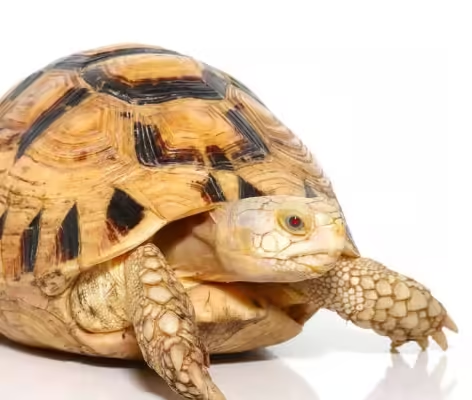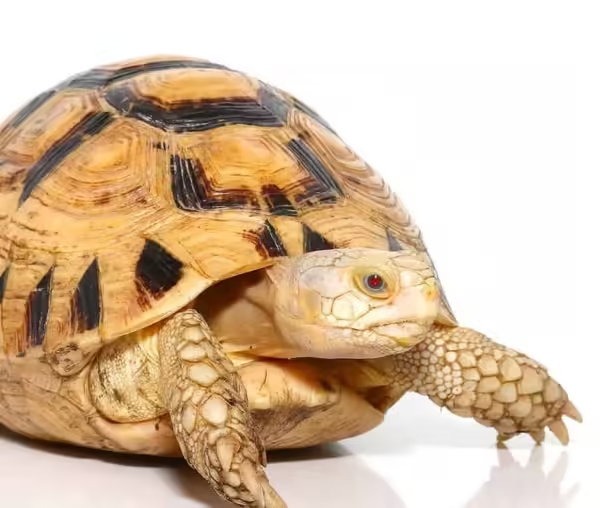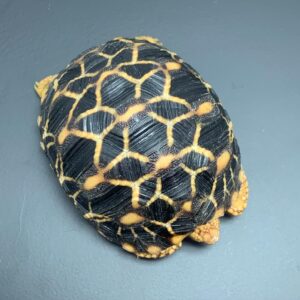Albino Greek Tortoise For Sale
$19,999.99
WE HAVE AN EXTREMELY RARE T+ ALBINO GREEK TORTOISE FOR SALE. HERE ARE SOME HIGHLIGHTS:
- Testudo graeca
- Also Known As The “Mesopotamian Tortoise”
- Farm Bred Female
- Approximately 6 – 7 Inches In Shell Length
- Adults Are Growing To Sizes Of 7 – 8+ Inches In Shell Length
- Voracious Little Foragers Feeding On Fresh Veggies, Fresh Greens, Mixed Vegetables, And Fruits
FUN FACTS!
- Extremely Rare Albino Tortoise Morph, Very Difficult To Come Across
- These Are Great Personable Tortoises That Really Become Part Of The Family
- Indigenous To North Africa, Southwest Asia, And Southern Europe
- Coming From Its Natural Environment Of Rocky Hills, Mediterranean Scrubland, Forests, Fields, And Meadows
- We Recommend Higher Humid And Warm Temperatures For These Tortoises With Hiding Spots, Water Dishes, With A 50/50 Mixture Of Loose And Bark Substrate
- Zoo Quality Animal That Will Be A Magnificent Breeding Project
- With Proper Care And Handling These Tortoises Can Live 50 – 100+ Years In Captivity
Description
The Albino Greek Tortoise, scientifically known as Testudo graeca, presents an extraordinary genetic anomaly within the reptile world. As a subspecies of the more common Greek tortoise, this unique reptile stands out due to its lack of pigmentation, a condition known as albinism. This lack of melanin results in a striking appearance, characterized by a pale, almost translucent shell and pinkish eyes, setting it apart dramatically from its typically pigmented relatives.
Native to the Mediterranean region, the Greek tortoise’s habitat spans across countries such as Greece, Turkey, and parts of North Africa. These tortoises thrive in arid environments, ranging from semi-desert scrublands to rocky hillsides. The Albino Greek Tortoise, despite its rarity, shares these same habitats, although its unique coloration makes it more susceptible to predation and environmental stresses, given its reduced natural camouflage.
Albino reptiles, in general, hold a particular fascination for both scientists and reptile enthusiasts. The rarity of albinism in the wild, coupled with the distinct aesthetic appeal of albino animals, enhances their allure. For the Albino Greek Tortoise, this rarity translates into a high level of interest and concern for conservation efforts. These efforts are essential in ensuring that such unique genetic variations are preserved within their natural ecosystems.
The fascination with the Albino Greek Tortoise extends beyond its appearance. It serves as a living example of genetic diversity and the complex interplay of heredity and environment in shaping the characteristics of species. Understanding and appreciating these unique tortoises not only broadens our knowledge of reptilian biology but also underscores the importance of preserving biodiversity in all its forms.
Physical Characteristics and Appearance
The Albino Greek Tortoise is a captivating example of genetic variation within the species. One of the most striking features of this tortoise is its shell, which, unlike the typical dark and earthy tones of the standard Greek Tortoise, exhibits a pale, almost translucent quality. The lack of pigmentation, a hallmark of albinism, results in a shell that ranges in color from creamy white to soft yellow. This unique coloration not only makes the albino variant easily distinguishable but also adds to its allure.
The skin of the Albino Greek Tortoise complements this unusual shell color. Without the melanin pigmentation that characterizes most tortoises, their skin appears a light, almost pinkish hue. This stark contrast to the typical olive or brown skin of the standard Greek Tortoise further accentuates the albino’s rare appearance. Additionally, the scales covering their limbs and head are less vividly colored, often matching the lighter tones of their shell.
Perhaps one of the most fascinating aspects of the Albino Greek Tortoise is its eyes. In the absence of melanin, their eyes take on a reddish or pinkish tint, a common trait among albino animals. This is due to the visibility of blood vessels through the transparent layers of the eye, giving them a hauntingly beautiful look that sets them apart from their non-albino counterparts, which usually have dark, almost black eyes.
When comparing the Albino Greek Tortoise to the standard Greek Tortoise, the differences are quite pronounced. The standard Greek Tortoise boasts a more camouflaged appearance suited for their natural habitats, with shells and skin that blend seamlessly into the earthy and vegetative environments. In contrast, the albino variant, with its lack of pigmentation, stands out dramatically, making it a rare and cherished subject for both researchers and enthusiasts. The albino traits not only enhance the tortoise’s visual appeal but also reflect the fascinating complexities of genetic diversity within the species.
Habitat and Natural Environment
The Greek Tortoise, including its rare albino variant, is indigenous to several regions in Southern Europe and the Mediterranean. These tortoises are predominantly found in countries such as Greece, Italy, Turkey, and parts of North Africa. The geographical distribution is closely tied to areas that offer a temperate to Mediterranean climate, which provides the ideal environmental conditions for their survival and well-being.
Greek Tortoises thrive in environments characterized by warm, dry summers and mild, wet winters. They are typically found in arid to semi-arid regions with sparse vegetation, such as scrublands, rocky hillsides, and grasslands. Such landscapes provide ample basking spots and hiding places, essential for thermoregulation and protection from predators. The albino Greek Tortoise, despite its unique coloration, shares the same habitat preferences as its non-albino counterparts, relying on the same environmental features for survival.
The natural environment of the Greek Tortoise influences their behavior and lifestyle significantly. During the warm months, these tortoises are primarily diurnal, actively foraging for food in the early morning and late afternoon to avoid the intense midday heat. Their diet mainly consists of a variety of grasses, herbs, and other vegetation available in their habitat. The availability of these food sources is crucial for their nutritional needs and overall health.
In colder months, Greek Tortoises enter a state of brumation, a hibernation-like period where their metabolic rate slows down considerably. They seek refuge in burrows or under dense vegetation to protect themselves from the cold. This seasonal behavior is a direct response to the climatic conditions of their natural environment, ensuring their survival during periods of low temperatures and limited food availability.
Understanding the habitat and natural environment of the Greek Tortoise, including the albino variant, is essential for conservation efforts. By protecting their natural habitats and ensuring the conditions they thrive in, we can contribute to the preservation of these fascinating reptiles for future generations.
Diet and Nutrition
The Albino Greek Tortoise, like its non-albino counterparts, has specific dietary needs that must be met to ensure its health and longevity. In the wild, these tortoises primarily consume a variety of plants and insects. Their diet is predominantly herbivorous, with a preference for leafy greens, flowers, and fruits. They are known to feed on grasses, dandelions, clovers, and occasionally, small invertebrates such as beetles and worms. This diverse diet provides them with the necessary nutrients to thrive in their natural habitat.
For those who are considering keeping an Albino Greek Tortoise as a pet, understanding their dietary requirements is crucial. A balanced diet should mimic their natural food sources as closely as possible. Fresh, pesticide-free greens should form the bulk of their diet. Offer them a variety of leafy vegetables such as kale, collard greens, and turnip greens. Additionally, you can include edible flowers like hibiscus and dandelion flowers to provide variety and additional nutrients.
Fruits should be given sparingly, as they contain high levels of sugars that can lead to health issues if consumed in large quantities. Safe options include strawberries, apples, and melons, but these should only be a small part of their overall diet. It’s also important to provide a source of protein, which can be achieved by including small amounts of insects like mealworms or commercial tortoise diets that contain the necessary protein content.
Feeding schedules for Albino Greek Tortoises should be consistent. They generally require daily feeding, with the amount of food adjusted according to their size and activity level. Young tortoises and those that are growing may need more frequent feedings compared to adult tortoises.
Lastly, dietary supplements are essential to ensure your tortoise receives all the necessary vitamins and minerals. Calcium is particularly important for shell and bone health. A calcium supplement can be sprinkled on their food several times a week. Additionally, a multivitamin supplement can be provided once a week to cover any potential nutritional gaps.
Behavior and Temperament
The Albino Greek Tortoise is renowned for its gentle and docile nature, making it a popular choice among reptile enthusiasts. These tortoises are generally calm and non-aggressive, exhibiting a placid temperament that stands out in the reptile world. Their daily activities primarily revolve around basking, foraging, and exploring their environment. Albino Greek Tortoises are daylight creatures, taking advantage of the sun to regulate their body temperature and engage in their usual activities.
Social interactions among Albino Greek Tortoises are relatively limited, as they tend to be solitary animals. While they can coexist peacefully with other tortoises, they do not rely on social interaction for their well-being. However, they do exhibit a range of behaviors that indicate their mood and comfort levels. For instance, a relaxed tortoise will often be seen stretching out its limbs while basking, whereas a stressed or threatened tortoise may retreat into its shell or display defensive behaviors.
When it comes to human interaction, Albino Greek Tortoises can be quite engaging. They often recognize their owners and may respond to their presence, especially when food is involved. Though they are not affectionate in the way mammals are, they can form a bond with their caretakers, showing signs of recognition and trust over time. Handling should be done gently and infrequently to avoid causing stress to the tortoise. Providing a stable and enriching environment is crucial for their mental and physical well-being.
Unique behavioral traits of the Albino Greek Tortoise include their keen sense of exploration and curiosity. They enjoy investigating new objects and terrains within their enclosure, which can be encouraged through the introduction of safe, stimulating decor. Potential owners should be prepared for a long-term commitment, as these tortoises can live for several decades, requiring consistent care and attention to thrive.
Health and Common Issues
The Albino Greek Tortoise, like other tortoises, requires diligent care to maintain its health and well-being. Owners must be aware of common health issues that this species may encounter to ensure their pet remains in optimal condition. One of the primary concerns for the Albino Greek Tortoise is shell rot. This condition is typically caused by prolonged exposure to damp environments, resulting in bacterial or fungal infections that affect the shell. To prevent shell rot, it is essential to provide a dry, clean habitat and to monitor the tortoise’s shell for any signs of softening, discoloration, or foul odor.
Another prevalent health issue is respiratory infections, often resulting from inadequate temperature regulation within the enclosure. Symptoms such as wheezing, nasal discharge, and lethargy may indicate a respiratory problem. Ensuring that the tortoise’s habitat maintains appropriate temperature gradients and humidity levels is crucial in preventing these infections. Additionally, regular health check-ups with a reptile veterinarian can help detect and treat respiratory issues early on.
Nutritional deficiencies are also a common concern for the Albino Greek Tortoise. Their diet should consist of a variety of leafy greens, vegetables, and calcium supplements to prevent issues such as metabolic bone disease. Signs of nutritional deficiencies include soft or deformed shells, lack of appetite, and sluggishness. Owners should provide a well-balanced diet and ensure that the tortoise has access to UVB lighting, which is vital for calcium metabolism and overall health.
Preventive care plays a significant role in maintaining the health of the Albino Greek Tortoise. Regularly cleaning the enclosure, providing a balanced diet, and monitoring environmental conditions are key practices. Additionally, being vigilant about changes in behavior or physical appearance can help identify potential health issues early. If any signs of illness are observed, it is imperative to seek veterinary assistance promptly to address and treat the condition effectively.
By adhering to these guidelines, owners can help ensure that their Albino Greek Tortoise remains healthy and thrives in captivity.
Breeding and Reproduction
Albino Greek Tortoises exhibit intriguing breeding habits and reproductive cycles, which are essential for sustaining their population, especially in captivity. Mating behaviors in these tortoises typically commence in the spring, shortly after the end of their hibernation period. During this time, male tortoises become more active and engage in courtship rituals to attract females. These rituals often involve gentle nipping, circling, and head bobbing. Successful mating may lead to the female storing sperm for several years, allowing her to lay fertilized eggs even without subsequent mating.
Nesting is a critical phase in the reproductive cycle. Female Albino Greek Tortoises seek out suitable nesting sites, which are typically characterized by loose, sandy soil that is easy to dig. Once a site is chosen, the female digs a nest chamber where she deposits her eggs. Clutch sizes can vary, but typically, a female may lay between 3 to 12 eggs per clutch. After laying her eggs, the female carefully covers the nest with soil to protect it from predators and environmental factors.
The incubation process is influenced by environmental conditions, particularly temperature. For Albino Greek Tortoises, the ideal incubation temperature ranges between 28-32°C (82-90°F). The eggs generally take about 60 to 90 days to hatch, depending on the ambient temperature. Hatchlings emerge from their eggs using a specialized egg tooth, and they remain in the nest for a few days before venturing out into the world.
Breeding albino tortoises in captivity presents unique challenges and considerations. Genetic factors play a significant role, as the albino trait is a recessive genetic mutation. Breeders need to be mindful of the potential for inbreeding, which can lead to health issues and reduced genetic diversity. Ethical concerns also arise, particularly regarding the welfare of the tortoises and the potential for overbreeding. Ensuring that breeding programs prioritize the health and well-being of the tortoises is paramount to maintaining a sustainable and ethically sound population.
Conservation Status and Efforts
The Albino Greek Tortoise, a rare and captivating species, faces significant conservation challenges. The primary threats to their population include habitat destruction and the illegal pet trade. Urbanization and agricultural expansion have resulted in the loss of natural habitats, disrupting the delicate ecosystems these tortoises rely on for survival. Additionally, the allure of this unique reptile has led to an increase in illegal collection and trade, further endangering their populations.
In response to these threats, various conservation efforts are underway to protect and preserve the Albino Greek Tortoise. Organizations and wildlife conservation groups are actively working to create and maintain protected areas that safeguard the tortoise’s natural habitats. These protected zones are crucial in ensuring that the tortoises have a safe environment to thrive and reproduce.
Furthermore, breeding programs in captivity have been initiated to support population numbers. These programs aim to breed Albino Greek Tortoises in controlled environments, with the goal of eventually reintroducing them into the wild. Such initiatives not only help increase population numbers but also contribute to genetic diversity, which is vital for the long-term survival of the species.
Education and awareness campaigns play a pivotal role in conservation efforts. By educating the public about the importance of preserving the Albino Greek Tortoise and the threats they face, conservationists hope to reduce the demand for these tortoises in the illegal pet trade. Additionally, these campaigns encourage responsible pet ownership and wildlife protection practices among communities.
Individuals can also contribute to the conservation of the Albino Greek Tortoise. Supporting reputable conservation organizations through donations or volunteer work can make a significant impact. Moreover, advocating for stronger wildlife protection laws and participating in local conservation initiatives are effective ways to help safeguard this remarkable species.
Through coordinated efforts and sustained commitment, it is possible to ensure the continued survival of the Albino Greek Tortoise, allowing future generations to marvel at this extraordinary creature.






